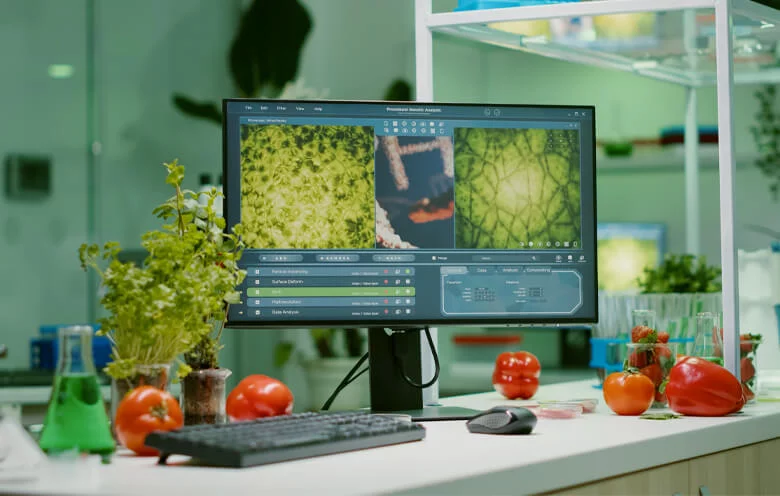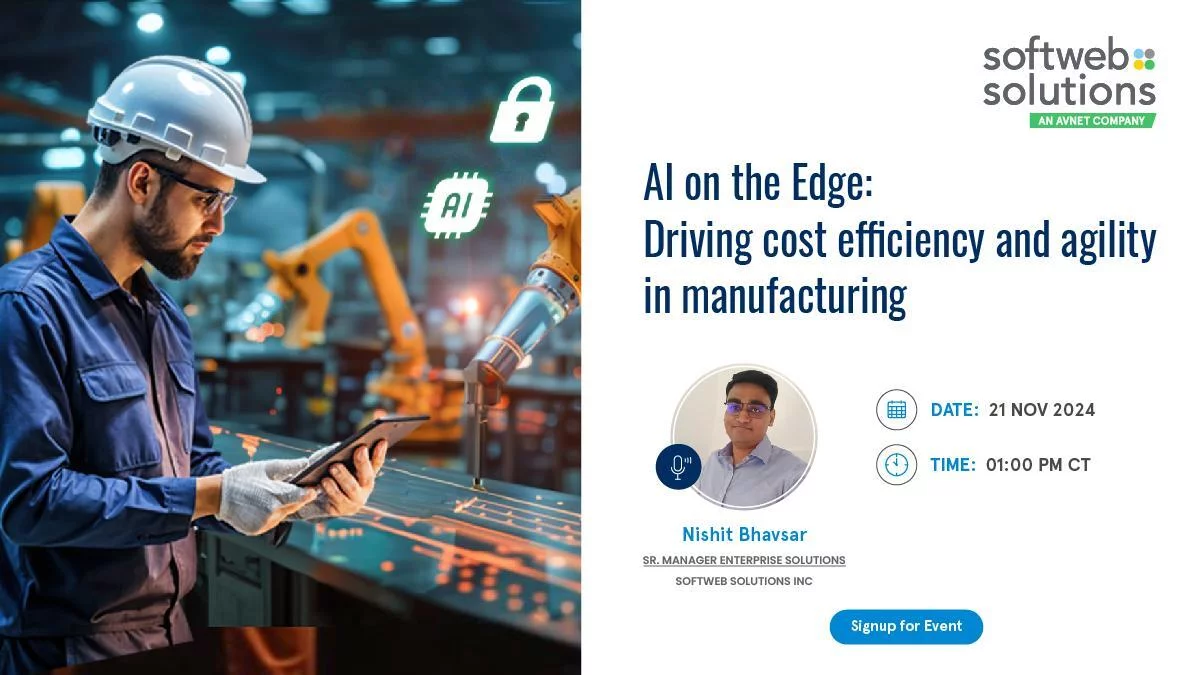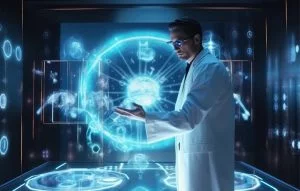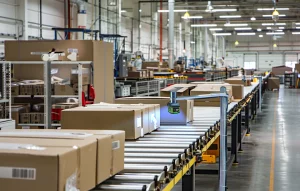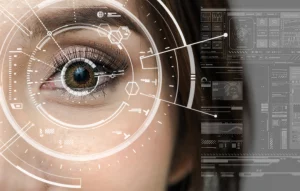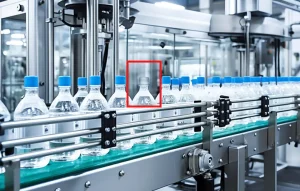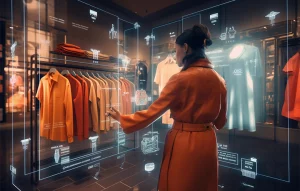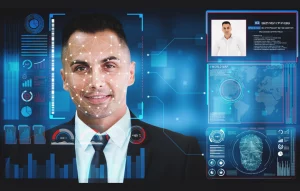Forget the days of squinting factory floor inspectors and unreliable manual checks. In the food manufacturing industry, precision and efficiency have a new name: computer vision (CV).
99% of video/image content captured for enterprise purposes will be analyzed by machines rather than humans. (Deloitte)
For decision-makers seeking innovative solutions to enhance efficiency and quality control, integrating computer vision technology is a strategic move. In this blog, we will explore how computer vision development is revolutionizing the food industry, specifically focusing on quality checks, sorting, counting, measuring, and packaging.
How computer vision is applied in the food industry
Picture computer vision as your personal assistant in food manufacturing. This AI technology interprets visual data and, when combined with machine learning, ensures your processes meet top-notch standards. Beyond human capabilities, it meticulously assesses both external and internal aspects, enhancing precision, maintaining consistency, and delivering top-quality, safe food products. With computer vision and machine learning algorithms, manufacturing becomes a personalized, efficient journey, standing for your commitment to excellence in every product.
Computer vision models are powerful tools that use various techniques to thoroughly examine food products:
Computer vision and infrared:
Purpose: Identify surface defects
How: Uses infrared light to spot blemishes, discolorations, and foreign objects on the surface of food products.
Hyperspectral and multispectral imaging:
Purpose: Understand the internal structure and composition
How: Captures data across different wavelengths to reveal internal properties like freshness and ripeness.
Tomographic techniques:
Purpose: Provide 3D insights
How: Acts like a virtual X-ray, offering three-dimensional views to ensure uniformity and consistency.
Image processing:
Purpose: Analyze images for actionable insights
How: Algorithms analyze captured images, guiding automated actions like sorting and defect detection.
Check out our blog on top 9 applications of computer vision in manufacturing
3 ways to deploy computer vision technology in food manufacturing companies
1. Quality check:
Ensuring top-tier quality is a cornerstone of your food manufacturing process, and computer vision appears as a game-changer in this crucial aspect. Leveraging advanced algorithms and cutting-edge technology, computer vision automates visual inspections, ensuring a meticulous examination of every product to meet your specified quality criteria.
- Automation mastery: Streamline your quality check process. Computer vision takes charge with automated visual inspections.
- Algorithmic scrutiny: Harness advanced algorithms. The technology analyzes color, shape, size, and texture to ensure adherence to your quality criteria.
- Defect precision: Identify deviations from your desired standards, contributing to enhanced product quality.
- Human error mitigation: The seamless automation significantly reduces the likelihood of your team encountering human error.
- Efficiency unleashed: The result is an efficient and reliable inspection process, ensuring the delivery of high-quality products to your consumers.
2. Sorting, counting, and measuring:
Computer vision technology enables food manufacturers to automate sorting processes based on predefined characteristics. Whether you use it for sorting fruits by ripeness or separating defective items from the production line, this technology ensures accuracy and speed. Additionally, the technology helps in counting and measuring products with precision while optimizing your inventory management and minimizing waste.
- Automated sorting: Computer vision seamlessly automates sorting processes based on predefined characteristics.
- Swift defect identification: Whether it’s separating defective items or ensuring flawless products, computer vision excels at maintaining operational speed.
- Precision counting: The technology helps in counting products with unmatched precision, contributing to efficient inventory management.
- Efficiency boost: Automated processes enhance overall efficiency, ensuring a streamlined and swift production cycle.
- Wastage reduction: With precise counting and sorting, computer vision plays a key role in minimizing waste and optimizing resources for sustainable production.
3. Packaging:
Efficient packaging is not just a process; it’s a crucial touchpoint for your brand, and here’s where computer vision becomes your invaluable partner. Automated systems, supercharged by the prowess of computer vision, take center stage in identifying packaging defects with unmatched precision, allowing only perfection to grace the market.
This isn’t about flawless packaging; it’s about enhancing the visual allure of your products and, more importantly, reducing the chances of recalls associated with packaging issues.
- Precision identification: Computer vision ensures accurate identification of packaging defects, maintaining high standards.
- Flawless presentation: Automated systems enhance the visual appeal of products by allowing only flawless packaging to proceed.
- Reduced recalls: The technology minimizes the chances of recalls, safeguarding against potential issues with the packaging.
- Enhanced efficiency: Automated packaging inspection accelerates the process, contributing to overall operational efficiency.
- Reliable quality assurance: Computer vision provides a reliable quality assurance mechanism, instilling confidence in the consistency of packaging standards.
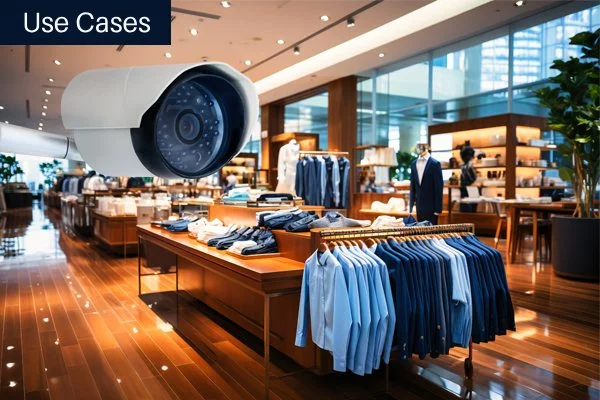
Explore 10 comprehensive use cases of computer vision in retail
Get ahead in fast-paced world with cutting-edge tech. This document dives into how it enhances customer experience, streamlines operations, and makes you a retail frontrunner.
Benefits of automated visual inspection using computer vision
Incorporating computer vision AI into your processes brings forth a myriad of advantages:
- Increased accuracy: Computer vision systems elevate quality control to new heights, surpassing human capabilities and ensuring an unparalleled level of accuracy in inspections. Your products undergo scrutiny with precision that significantly minimizes errors.
- Enhanced efficiency: The automation of visual inspection processes acts as a catalyst for faster production cycles. This heightened efficiency empowers food manufacturers to not only meet but exceed demand and deadlines, ensuring a seamless workflow.
- Cost savings: Automated visual inspection isn’t about precision; it’s a strategic cost-saving measure. By reducing human intervention and associated errors, this technology becomes a cornerstone for significant savings in both time and resources. It’s an investment in efficiency that pays dividends on your bottom line.
Read our case study on how we helped a US-based facility management firm solve problems with computer vision
Navigating the challenges of implementing computer vision in your food business
While the advantages of incorporating computer vision into the food industry are clear, there are certain challenges that demand attention. Here’s how we address them:
Strategic investment for future success:
Challenge: Embracing computer vision requires a significant initial investment.
Solution: Consider it a strategic investment in your future success, leveraging our expertise to optimize costs and enhance returns over time.
Integration expertise for seamless processes:
Challenge: Integrating computer vision into existing manufacturing processes is complex.
Solution: Our team specializes in meticulous planning and coordination, ensuring seamless integration tailored to your business needs.
Adapting to evolving technology:
Challenge: Keeping up with rapidly evolving technology demands continuous updates and maintenance.
Solution: We are committed to not only keeping your computer vision systems up-to-date but also optimizing them for the latest advancements, providing enduring value for your business.
Let’s conquer these challenges together, shaping a brighter technological future for your food business.
In closing: A visionary step towards your food manufacturing success
For leaders in food manufacturing, welcoming computer vision isn’t just a smart move—it’s your personalized path to efficiency, accuracy, and top-notch quality control. If you are ready to integrate this game-changer into your existing setup and enable automated visual inspection, let’s have a chat with our experts. Your journey to a more streamlined and efficient food manufacturing process begins with our computer vision services!


